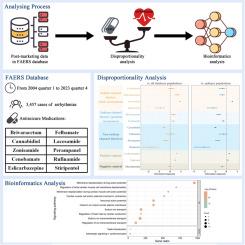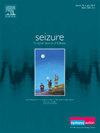Exploration of the potential association between newer antiseizure medications and arrhythmias: Integrating pharmacovigilance and bioinformatics evidence
IF 2.7
3区 医学
Q2 CLINICAL NEUROLOGY
引用次数: 0
Abstract
Introduction
Arrhythmias resulting from newer antiseizure medications (ASMs) may significantly impact the safety and quality of life of patients with epilepsy. This study investigated the potential association between new first-line or second-line ASMs and arrhythmias.
Methods
Pharmacovigilance analysis was conducted using data from the Food and Drug Administration Adverse Event Reporting System (FAERS) from 2004 to 2023. A disproportionality analysis was performed to compare newer ASMs with other drugs, using carbamazepine and valproate as positive controls. Newer ASMs were categorized into sodium channel (SCN) main mechanism, SCN possible mechanism, and non-SCN group. The bioinformatics analysis involved retrieving therapeutic gene targets for ASMs from the DrugBank and OMIM databases, as well as identifying arrhythmia disease targets from the GeneCards database. Additionally, enrichment analysis of gene ontology functions and KEGG pathways was conducted.
Results
A total of 3,457 cases of arrhythmias associated with newer ASMs were identified in the FAERS database. Disproportionality analysis indicates that brivaracetam (IC025 = 0.08), zonisamide (IC025 = 0.13), eslicarbazepine (IC025 = 0.39), and lacosamide (IC025 = 0.84) exhibited a positive signal for arrhythmias, with signals predominantly observed in the SCN main mechanism group. Furthermore, bioinformatics analysis revealed the involvement of adrenergic signaling in cardiac myocytes, as well as the participation of sodium channel genes in ASM-induced arrhythmias.
Conclusion
Our findings suggest a potential association between SCN-ASMs and arrhythmias, highlighting the importance of monitoring and evaluating the safety profiles of newer ASMs in clinical practice. Further research is necessary to elucidate the underlying mechanisms and inform patient care strategies.

探索新型抗癫痫药物与心律失常之间的潜在关联:整合药物警戒和生物信息学证据。
简介:新型抗癫痫药物(ASM)导致的心律失常可能会严重影响癫痫患者的安全和生活质量。本研究调查了新型一线或二线抗癫痫药物与心律失常之间的潜在关联:方法:利用食品药品管理局不良事件报告系统(FAERS)2004年至2023年的数据进行药物警戒分析。以卡马西平和丙戊酸钠为阳性对照,对新型 ASMs 与其他药物进行了比例失调分析比较。新型 ASMs 被分为钠通道(SCN)主要机制、SCN 可能机制和非 SCN 组。生物信息学分析包括从 DrugBank 和 OMIM 数据库中检索 ASM 的治疗基因靶点,以及从 GeneCards 数据库中识别心律失常疾病靶点。此外,还对基因本体功能和 KEGG 通路进行了富集分析:结果:FAERS 数据库共发现 3,457 例与新型 ASM 相关的心律失常病例。比例失调分析表明,布维伐他西酰胺(IC025 = 0.08)、唑尼沙胺(IC025 = 0.13)、埃利卡西平(IC025 = 0.39)和拉科沙胺(IC025 = 0.84)显示出心律失常的阳性信号,信号主要在SCN主要机制组中观察到。此外,生物信息学分析表明,心肌细胞中的肾上腺素能信号传导以及钠通道基因参与了 ASM 诱导的心律失常:我们的研究结果表明,SCN-ASM 与心律失常之间可能存在关联,这凸显了在临床实践中监测和评估新型 ASM 安全性的重要性。有必要开展进一步研究,以阐明其潜在机制并为患者护理策略提供依据。
本文章由计算机程序翻译,如有差异,请以英文原文为准。
求助全文
约1分钟内获得全文
求助全文
来源期刊

Seizure-European Journal of Epilepsy
医学-临床神经学
CiteScore
5.60
自引率
6.70%
发文量
231
审稿时长
34 days
期刊介绍:
Seizure - European Journal of Epilepsy is an international journal owned by Epilepsy Action (the largest member led epilepsy organisation in the UK). It provides a forum for papers on all topics related to epilepsy and seizure disorders.
 求助内容:
求助内容: 应助结果提醒方式:
应助结果提醒方式:


